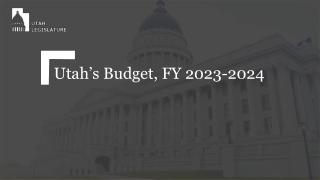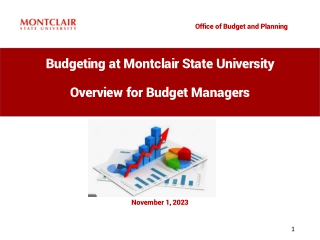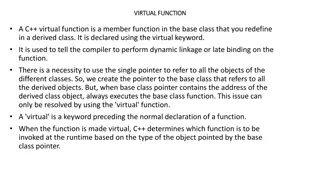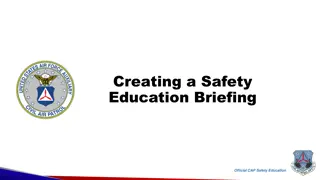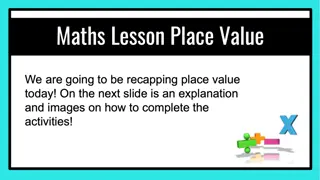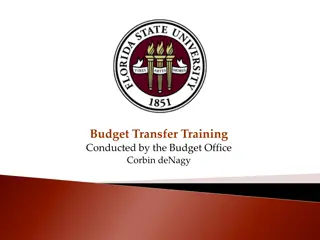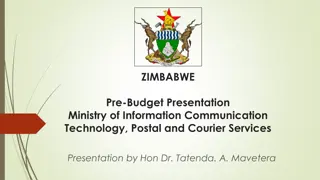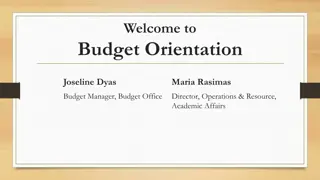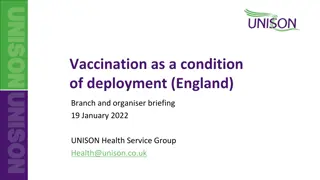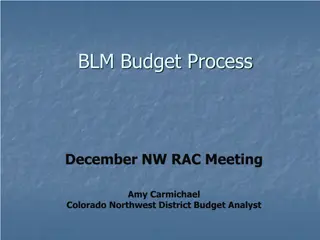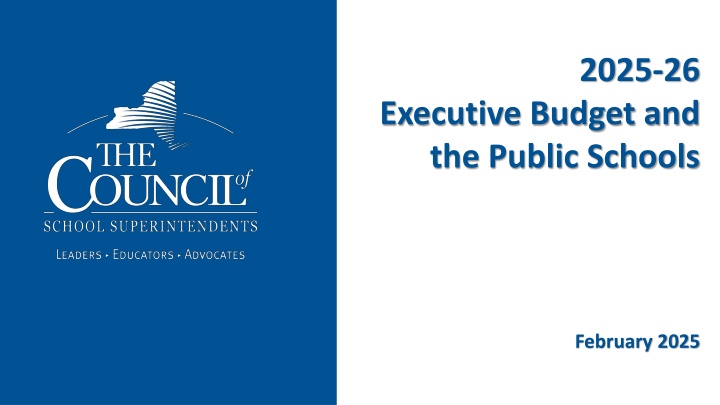
State Budget and Education Outlook 2025-26
Explore the 2025-26 Executive Budget's impact on public schools in light of the state's fiscal position, including forecasts, surplus, deficits, and proposed increases in school aid. Delve into the significant role of education and health care spending in the state budget and the theme of affordability. Gain insights into the Governor's proposed budget for education, focusing on school aid increases, funding adjustments, and key initiatives.
Download Presentation

Please find below an Image/Link to download the presentation.
The content on the website is provided AS IS for your information and personal use only. It may not be sold, licensed, or shared on other websites without obtaining consent from the author. If you encounter any issues during the download, it is possible that the publisher has removed the file from their server.
You are allowed to download the files provided on this website for personal or commercial use, subject to the condition that they are used lawfully. All files are the property of their respective owners.
The content on the website is provided AS IS for your information and personal use only. It may not be sold, licensed, or shared on other websites without obtaining consent from the author.
E N D
Presentation Transcript
2025-26 Executive Budget and the Public Schools February 2025
Current state fiscal position is strong, but outlook is uncertain October 2024: Mid-Year State Financial Plan forecast a $1.02 billion structural deficit for 2025-26 equivalent to 0.7% of projected spending. January 2025: Executive Budget Financial Plan reports total State Operating Funds receipts for 2024-25 up $7.4 billion (5.5%) from October, state projected to end current year with a $5.3 billion surplus. Principal state reserves total $21.1 billion, up from $5.6 billion in 2021. But Division of the Budget projects greater than typical structural deficits in future years and federal actions could dramatically further worsen outlook. Projected Surplus/(Deficit) Projected School Aid Increase $ Billions % of Spending $ Billons % 0 1.694 4.7% 2025-26 0 (4.3%) 1.060 2.8% 2026-27 (6.5) (6.2%) 1.085 2.8% 2027-28 (9.8) (6.7%) 1.122 2.8% 2028-29 (11.0) SOURCE: Compiled from NYS Division of the Budget, 2025-26 Executive Budget State Financial Plan 2
Education and Health Care in the State Budget Total 2024-25 Disbursements ($ in Billions) State Funds Federal Funds All Funds Total Education Department Health Department Everything Else 133.3 39.8 34.6 59.0 110.0 9.2 73.1 27.7 243.4 49.0 107.7 86.7 Education and health care account for 56% of state-funded spending and 64% of all funds spending SOURCE: Compiled from NYSDOB 2025-26 Executive Budget Financial Plan Program Medicaid Essential Plan Child Health Plus Enrollees 9 million New Yorkers rely on state programs for health insurance federal aid accounts for nearly $80 billion of cost 7,013,685 1,457,388 589,012 SOURCE: NYSDOB 2025-26 Executive Budget Financial Plan 3
Affordability is the theme of the year Excerpt from Budget Director s technical presentation, January 21, 2025 4
Governors Proposed Budget for Education The Big Picture $1.69 billion (4.8%) Increase in total School Aid on run; includes $1.46 billion (5.9%) increase in Foundation Aid Expense-based and categorical aids funded according to formulas in current law, generating a net $230 million (2.2%) increase figures for all districts match November estimates from State Education Department $160 million increase to fund Universal School Meals New funding stream and reporting requirement for dual enrollment classes $12.2 million Distraction Free Schools smartphone ban No changes related to zero-emission school bus transition Extension of retiree earnings limit extension not proposed 5
Foundation Aid Background Foundation Aid = [(Foundation Amount X Pupil Needs Index X Regional Cost Index) Expected Local Contribution] X Selected TAFPU (weighted pupil count) Formula Amount or Full Funding Amount the result of the above calculation Save-Harmless for decades, the state has ensured that, whatever the formula calculations might produce, districts will not receive a reduction from prior year funding in Foundation Aid, or the general-purpose operating aid formulas which preceded it We speak of districts as being on the formula or on save-harmless. 6
Foundation Aid Background continued5 Core Elements 1) Foundation Amount: Same for all districts $8,040 per pupil for 2024-25, adjusted annually by inflation (an average of 3.1% per year since 2007-08; 2.9% for 2025-26). Intended to represent spending necessary to support adequate general education, exclusive of costs aided through other formulas; based on spending of districts deemed successful based on state assessment results Successful Schools Model. 2) Pupil Needs Index:Based on 3-year average % of K-6 Free/Reduced Price Lunch eligible enrollment, 2000 Census poverty rate, English Language Learners, and a sparsity factor (can benefit districts with <25 students per square mile). 3) Regional Cost Index: Divides state into nine regions; index is based on wages and salaries of workers with credentials similar to those required of teachers; index values have never been updated. 4) Expected Local Contribution: Allows two options for calculating; both vary based district on property wealth and resident income per pupil and are affected by how district compares to state as a whole. 5) Selected TAFPU (Total Aidable Foundation Pupil Units): Average Daily Membership, plus weightings (e.g., 1.41 for students with disabilities, .5 for declassified students, .12 for summer school students); more favorable of latest TAFPU or 2-year average (cushions declines). 7
Major Rockefeller Institute Foundation Aid Recommendations Formula Element Foundation Amount Recommendations While other research proceeds, recalculate Successful Schools Model using results from grades 3-8 math and ELA assessments to identify successful districts; use 5-year average change in Northeast US CPI as inflation adjustment; would not add new costs. With a suggested 6% adjustment, the effect of this should be neutral for all districts. Replace 2000 Census poverty and free and reduced-price lunch data; add factor for extent of poverty; vary weight for English Language Learners; consider making sparsity aid a separate formula. Impact on individual districts would vary and is impossible to forecast without resolving details. Pupil Needs Index (PNI) Replace current nine-region RCI with a county or district-specific RCI. Report states approximately 3/4ths of districts would have higher RCI values, impact on individual districts will depend on details. Regional Cost Index (RCI) Eliminate 0.650 floor and 3.000 ceiling applied to Income Wealth Index; measure income per capita rather than per student. Allow districts to use most favorable of three blends on property wealth and income current 50-50 or 70-30, 30-70. Flatten/smooth curve in State Sharing Ratio (SSR). Eliminating IWI floor would help some districts. Blend options should benefit virtually all districts. Changing curve in SSR would negatively affect some districts. Expected Local Contribution Remove special education from Foundation Aid, fund as a categorical aid (as was done prior to Foundation Aid), vary weighting for students with disabilities. Impact on individual district cannot be calculated without more details. Could be beneficial for all districts. Weighted Pupil Count (Selected TAFPU) Report is at: https://rockinst.org/wp-content/uploads/2024/12/2024-12-Foundation-Aid-Report.pdf Executive Summary is on pages 11-19; Foreword on pages 9-10 is worth reading too. 8
Key passage in Rockefeller report (page 10) : [M]any of the recommendations in this report are developed and priced-out in isolation from each other. In most cases, each component of the Foundation Aid formula is examined for improvement opportunities on its own, and an impact is measured as if only that element is changed. It is recognized, of course, that elements in the Foundation Aid formula, at the very least, interact with each other and sometimes even may be fully dependent on one another. There also is no way to know which recommendations state policymakers might eventually approve and enact, or how districts may behave after having been given revised options, so there is simply no practical and reliable way to predict the final outcome of the reform proposals or to calculate every permutation of their collective impact. 9
Governors Foundation Aid Proposal 3 proposed changes 1) Replace poverty measures consistent with Rockefeller Institute report and Regents State Aid proposal: Current 2000 Census Poverty Free and Reduced-Price Lunch Eligibility Proposed Census Small Area Income and Poverty Estimates (updated annually) Economically Disadvantaged status 2) Modify State Sharing Ratio helps below average wealth districts 3) Add a 2% minimum increase 56% of districts benefit from preservation of save-harmless and 2% minimum 131 districts would have lower poverty counts under proposal, but impact for most is fully offset by other proposed changes and some others would still receive large increases (e.g., 8% instead of 10%). New York City would receive $347 million less than under current law due to change in poverty measures Entire School Aid database will be updated as of February 15 some aid figures will change 10
999999 Enter 6-digit "BEDS" Code here >> For a list of codes, click on CODE LIST tab below Hit "CTRL P" (i.e., control P) to print a report Our version of a user-friendly School Aid run 2025-26 School Aid Governor's Budget Proposal https://www.nyscoss.org/nyscossdocs/ Advocacy2425/2502_BT_Report.xlsx District: TOTAL STATE County: -- Aid Categories Foundation Aid Charter School Transition Aid High Tax Aid Summer Transportation Aid Transportation Aid w/o Summer Building Aid Building Reorganization Aid Operating Reorganization Incentive Aid Non-BOCES Computer Administration Aid Non-BOCES Career Education Aid Non-BOCES Academic Improvement Aid BOCES AID Public Excess Cost High Cost Aid Private Excess Cost Aid Software Aid Library Materials Aid Textbook Aid Hardware and Technology Aid Full-Day Kindergarten Conversion Aid Universal Prekindergarten Aid Supplemental Public Excess Cost Aid Academic Enhancement Aid Total Aid Total Aid excluding UPK Aid Total Aid excluding Building Aids 2024-25 2025-26 Change % Change 1,464,297,746 9,367,921 - 201 135,189,432 (107,809,496) (4,034,646) (657,077) 1,550,919 2,688,061 (241,752) 510,069 1,848,426 42,843,972 700,023 581,341 3,052,949 1,247,496 - 143,005,542 - - 1,694,141,127 1,551,135,585 1,805,985,269 24,926,667,873 51,257,010 223,298,324 2,536,638,374 3,435,301,357 11,435,661 32,223,054 153,475,879 56,260,249 1,312,781,103 629,480,874 475,910,274 41,927,760 17,204,029 162,039,566 33,921,866 1,067,980,871 28,271,832 35,207,754,716 34,139,773,845 31,761,017,698 26,390,965,619 60,624,931 223,298,324 2,671,827,806 3,327,491,861 33,773,973 156,163,940 56,018,497 1,313,291,172 631,329,300 518,754,246 42,627,783 17,785,370 165,092,515 35,169,362 1,210,986,413 28,271,832 36,901,895,843 35,690,909,430 33,567,002,967 5.9% 18.3% 0.0% 0.0% 5.3% -3.1% -35.3% -27.8% 4.8% 1.8% -0.4% 0.0% 0.3% 9.0% 1.7% 3.4% 1.9% 3.7% 4,999,660 4,999,861 7,401,015 1,708,856 2,365,933 - - NA 13.4% 0.0% 0.0% 4.8% 4.5% 5.7% 4,313,167 4,313,167 11 SOURCE: Compiled by NYSCOSS from New York State Education Department School Aid estimates as of 01/21/2025.
Changes in Estimates Over Time TOTAL STATE -- 2024-25 Aid 2025-26 Aid Change: Jan. '25 Apr. '24 (8,984,819) (5,923,671) (13,667,017) 17,977,772 134,368 (248,069) 13,056,141 3,995,837 28,908,942 (46,234,562) 3,618,123 (431,281) (469,206) (1,847,814) (636,918) (108,954,485) (119,706,755) Governor's Proposal Jan. 2025 26,390,965,619 60,624,931 223,298,324 4,999,861 2,671,827,806 3,327,491,861 7,401,015 1,708,856 33,773,973 156,163,940 56,018,497 1,313,291,172 631,329,300 518,754,246 42,627,783 17,785,370 165,092,515 35,169,362 1,210,986,413 4,313,167 28,271,832 36,901,895,843 Change: Enacted Budget TBD TBD TBD TBD TBD TBD TBD TBD TBD TBD TBD TBD TBD TBD TBD TBD TBD TBD TBD TBD TBD TBD TBD Enacted Gov. Proposal Aid Categories Foundation Aid Charter School Transition Aid High Tax Aid Summer Transportation Aid Transportation Aid w/o Summer Building Aid Building Reorganization Aid Operating Reorganization Incentive Aid Non-BOCES Computer Administration Aid Non-BOCES Career Education Aid Non-BOCES Academic Improvement Aid BOCES AID Public Excess Cost High Cost Aid Private Excess Cost Aid Software Aid Library Materials Aid Textbook Aid Hardware and Technology Aid Full-Day Kindergarten Conversion Aid Universal Prekindergarten Aid Supplemental Public Excess Cost Aid Academic Enhancement Aid TOTAL Apr. 2024 Jan. 2025 24,935,652,692 57,180,681 223,298,324 4,999,757 2,550,305,391 3,417,323,585 11,301,293 2,365,932 32,471,123 140,419,738 52,264,412 1,283,872,161 675,715,436 472,292,151 42,359,041 17,673,235 163,887,380 34,558,784 1,176,935,356 4,313,167 28,271,832 35,327,461,471 24,926,667,873 51,257,010 223,298,324 4,999,660 2,536,638,374 3,435,301,357 11,435,661 2,365,933 32,223,054 153,475,879 56,260,249 1,312,781,103 629,480,874 475,910,274 41,927,760 17,204,029 162,039,566 33,921,866 1,067,980,871 4,313,167 28,271,832 35,207,754,716 TBD TBD TBD TBD TBD TBD TBD TBD TBD TBD TBD TBD TBD TBD TBD TBD TBD TBD TBD TBD TBD TBD TBD - (97) 1 - - - - - - 12
Foundation Aid Funding Analysis District: County: NIAGARA FALLS CITY SD Niagara Amount of Save-Harmless Funding (if any) Save-Harmless as % of 2025-26 Foundation Aid Foundation Aid Governor's Proposal 2024-25 2025-26 Change 7,030,627 % Change 116,263,870 123,294,497 6.0% - 0.0% Selected Aid Factors Selected TAFPU (Weighted Pupils)* Property Wealth/Pupil Ratio** Combined Wealth Ratio** 0.353 K-6 Free and Reduced Price Eligible %*** English Language Learners Income/Pupil Ratio** 2007-08 9,703 0.298 0.409 67.2% 73 2022-23 2023-24 2024-25 2025-26 8,604 8,535 8,468 8,474 0.277 0.273 0.296 0.294 0.380 0.378 0.371 0.367 0.328 0.325 0.333 0.330 77.4% 77.8% 78.1% 78.4% 141 125 135 152 All figures in the table directly above are those used in calculating School Aid for that year and are typically derived from at least a year prior to the calculating year (e.g., 2024-25 enrollment for 2025-26 aid) Current Law 1.719 Gov. Proposal The Executive Budget proposes replacing poverty measures included in the Pupil Needs Index and modifying the State Sharing Ratio used to determine district local revenue contributions Pupil Needs Index State Sharing Ratio 1.730 93.0% 91.0% 2025-26 Selected Total Aidiable Foundation Pupil Units* November Projection Enacted Budget Count 8,474 TBD 13
Other funding issues The proposed budget would not: Increase funding for career and technical education by raising the aidable salary limit in BOCES Aid and improve funding Special Services Aid (for non-BOCES districts). Include an appropriation for prior year adjustments in state aid owed to school districts no funding has been provided since 2019-20 and the queue of unpaid claims now totals over $300 million. Provide a state share of funding for special education services to students through the school year in which they reach age 21 current law provides funding through age 21, but a federal court decision requires services through age 22. SED estimates total state cost of $66.5 million without considering changes in Foundation Aid. Discontinue the shift of special education residential placement costs onto school districts, a fiscal impact estimated to total $28.6 million on effected school districts outside New York City. The Executive Budget again proposes to freeze most state aid based on the calculations reflected in the Governor s proposal. 14
Distraction Free Schools The Governor proposes legislation to require districts and BOCES to adopt policies which would: Prohibit student use of internet-enabled devices on school grounds during the school day (during classes, study halls, recess, lunch periods, and passing time) Require schools to include and publicize one or more ways for parents to contact their children during the school day Require policies to include one or more methods for on-site storage of devices during the school day; student lockers are cited as one option Allow exemptions for instructional purposes authorized by a teacher, health management, translation services, where included in an IEP or 504 plan, or in case of emergency. Districts and BOCES would be required to post on their websites annual reports on enforcement of their policies, including data on any demographic disparities in enforcement. These requirements would be applied to charter schools 15
Universal Free School Meals Require all schools that participate in the national lunch/breakfast program to offer free meals to all students Include requirement that districts maximize all available federal dollars first Close the gap that existed since universal free meals was implemented to actual create universality Total appropriation is $340 million, an increase of $160 million over 2024-25 Project 2025 has proposed working towards elimination of Community Eligibility Program and at a minimum a 40% threshold with other constraints. If any of these occurs, the cost to the state of funding free school meals would balloon 16
Dual Enrollment Governor proposes $64.6 million College in High School Opportunity Fund. Most funding would support existing programs (Early College High Schools, PTECH, Smart Scholars), but $12.2 million would fund new dual enrollment opportunities up to $90 per credit for programs which Offer opportunity to earn at least 12 transferrable credits Provide counseling and support beyond what is offered to other students Serve a student population reflective of the district and include outreach to underserved students Have filed with SED a partnership agreement with a college and any other participating entities Legislation would direct SED to develop a dual enrollment policy which would require districts to have partnership agreements on file starting on September 1, 2026 and require districts and colleges to report data on dual enrollment participation and success. The Governor has prioritized improving access to college what about careers (i.e., CTE funding)? 17
Zero-Emission School Buses Some positive steps were taken in 2024 (e.g., reducing assumed amortization periods for ZEBs from 12 to 8 years), but not enough. Educational Conference Board recommendations: State should fund the cost of the transition State-funded route feasibility studies for all districts; ZEBs should only be required for routes deemed feasible Allow hybrid and low-emission buses as alternatives Require independent range estimates for ZEB school buses Require utilities to provide specialized rate structures for school districts and contractors Ensure regular stakeholder engagement 18
Retiree earnings limit exemption Last year, it was an uphill struggle to get the extension of the exemption from the $35,000 earnings limit for public sector retirees working in schools We were advised that it would not be extended again, but heard from superintendents there is a desperate need for the exemption to be extended Local advocacy will be crucial, we are also looking for stories on how ending the exemption would hurt schools and students We could support requiring an employer contribution on behalf of retirees working under the waiver We have also suggested lowering from 65 to 63 the age at which retirees could work without a waiver It could be helpful to suggest longer-term steps to help with hiring shortages for example, pension reciprocity with other states, child care in schools, some Tier 6 changes 19
Child Victims Act Claims Together with partners in the Educational Conference Board we are preparing a proposal to allow school districts and BOCES to finance payment of judgments and settlements on CVA claims over 30 years, instead the 15 years otherwise allowed for payments of claims. Obtaining student funding for payment of these claims is a non-starter. 20
NYSCOSS Top 10 Legislative Priorities Zero-Emission Bus Overhaul Retiree Earnings Limit Extension/Modification UPK Reforms and Child Care in Schools Child Victims Act Relief Civil Service Reform Enhance Student Safety Career and Technical Education Funding Increase Capital Outlay Limit Telehealth in Schools Special Education Reforms Note: With our Top 10, we try to focus on items which do not require state appropriations part of our annual budget advocacy is necessarily reactive (to the Governor s proposals) 21
Some Resources NYSCOSS Testimony for Legislative Budget Hearing, January 2025 Historical Data for All Districts Receiving Foundation Aid 2025-26 Current Law School Aid Estimates Summary Data NYSCOSS Testimony for Rockefeller Institute. August 2024 Foundation Aid What s Next? Recommendations for Principles and Process. Educational Conference Board. October 2023 Two-page summary of formula and issues Advocacy: Three Goals for Every Contact, COUNCILGRAM, August 2023 22
Questions, Ideas? Contact us at boblowry@nyscoss.org greg@nyscoss.org charles@nyscoss.org 23
Formula Elements and Rockefeller Recommendations (slides from December 11 Webinar) 24
Foundation Amount Explanation: A uniform per pupil amount for all districts ($8,040 for 2024-25). Arrived at through a Successful Schools Model average general education instructional expenditures of districts deemed to be successful on a collection of 8 state assessments. As an efficiency filter, only spending by the lower spending half of districts is considered. Developed to comply with court requirement to determine the cost of providing a sound basic education. Adjusted for inflation by annual change in the nationwide CPI (average of 3.1% annually through 2023- 24). Common Criticisms: SSM has not been updated in over 10 years and can t be due to changes in state standards and assessments. We and others have suggested that the measure should be tied to high school completion. Also, schools have had to take on additional costs since formula was enacted (e.g., mental health services, school security). 25
Foundation Amount, continued Report Recommendations: Recognizing other research underway, recommends using 3-year average of results on grades 3-8 ELA and math assessments. Use top 50% performing districts as successful. Do not apply efficiency filter. Resulting figure is less than current $8,040 per pupil consider scaling-up by 1.06, if other reforms are not adopted. Would not add new costs in defining the Foundation Amount. Would use a 5-year average of the Northeast U.S. region CPI as the inflation adjustment. 26
Pupil Needs Index Explanation: Based on four factors: 3-year average % of K-6 Free/Reduced Price Lunch (FRPL) eligible enrollment 2000 Census poverty rate % of students who are English Language Learners Sparsity factor (can benefit districts with <25 students per square mile) Common Criticisms: Impossible to justify using 24-year-old Census data. Problems have emerged with using FRPL data. Weight given to factors should be re-evaluated (e.g., 0.5 for ELLs) Additional student need factors should be considered concentration of poverty, homelessness, foster care placements, etc. 27
Pupil Needs Index, continued Report Recommendations: Replace 2000 Census poverty data with 3-year rolling average % of 5-17 year-olds in poverty in Small Area Income and Poverty Estimates (SAIPE) produced by Census Bureau. Apply variable weight to SAIPE factor higher weight for higher poverty Replace FRPL-eligibility with Economically Disadvantaged which counts students whose families benefit from one of several economic assistance programs. Apply variable weight to ELL factor tied to grade level, extent of services, and years of services for example, 0.65 for students with interrupted formal education (SIFE) or entering high school. No immediate change to Sparsity Factor recommended; does recommend direct state support to assist rural districts and consider making sparsity aid a separate formula. 28
Regional Cost Index Explanation: Divides state into 9 regions Index values are based on compensation of workers in occupations with credential requirements similar to those of educators. RCI values range from 1.000 for North Country and Mohawk Valley to 1.425 for New York City/Long Island Common Criticisms: Index values have never been updated (using over 17 year-old data) With only 9 large regions, differences in RCI values may not reflect actual cost differences within the region and can result in steep differences across regions for neighboring districts 29
Regional Cost Index, continued Current RCI Regions & Index Values Long Island/New York City Nassau New York City Suffolk 1.425 Hudson Valley Dutchess Orange Putnam Rockland Sullivan Ulster Westchester Capital District Albany Columbia Greene Rensselaer Saratoga Schenectady Warren Washington Southern Tier Broome Chemung Chenango Delaware Schuyler Steuben Tioga Tompkins Mohawk Valley Fulton Herkimer Montgomery Oneida Otsego Schoharie North Country Clinton Essex Franklin Hamilton Jefferson Lewis St. Lawrence Central New York Cayuga Cortland Madison Onondaga Oswego 1.314 1.124 1.045 1.000 1.000 1.103 Finger Lakes Genesee Livingston Monroe Ontario Orleans Seneca Wayne Wyoming Yates Western New York Allegany Cattaraugus Chautauqua Erie Niagara 1.141 1.091 30
Regional Cost Index, continued Report Recommendations: Replace current measure with Comparable Wage Index for Teachers (CWIFT); produced by the National Center for Education Statistics and is updated annually. CWIFT can be calculated at school district or county level. Nearly 3/4ths of districts would see RCI increase with this change. Could phase-in over 5 years. 31
Expected Local Contribution Explanation: Allows district to use most favorable of 3 options: Expected Tax Rate: Based on what district would raise with tax rate equal to 90% of the 3-year statewide average tax rate. Adjusted by an Income Wealth Index which may raise or lower the ELC; IWI has a floor of .650 and a ceiling of 2.000. Used by only 12 districts. State Sharing Ratio: Uses a four-tier calculation to generate a percentage of the Adjusted Foundation Amount* to be received by district. Percentage is based on Combined Wealth Ratio district property wealth and resident adjusted gross income per weighted pupil compared to statewide averages; property and income are each weighted at 50%. For both property and income, districts are permitted to use the lesser of either 2021 data or the average of 2021 and 2020 data. Used by 611 districts. $500 Flat Grant Minimum: A third option allows districts to receive $500 per pupil, if either of the two above calculations would generate less than that figure. Used by 45 districts. * Adjusted Foundation Amount = Foundation Amount X PNI X RCI 32
Expected Local Contribution, continued Common Criticisms: .650 IWI minimum overstates ability to pay of very poor districts (nearly of districts have an IWI <.650). When the Foundation Aid formula was enacted, there was no property tax cap an increase in property wealth could cause a district to lose Foundation Aid but the tax cap might not allow that district to realize offsetting local revenue without seeking and gaining a tax cap over-ride. There are significant lags in the property wealth and income data. Report Recommendations: Remove .650 IWI floor and raise IWI ceiling to 3.000 Calculate income per capita of 5-17 year-olds in district, rather than per public school pupil latter arguably overstates ability to pay in districts with many nonpublic students Allow districts to use most favorable of three blends of property and income current 50%/50%, or 70% property/30% income, or 30% property/70% income Replace four-tier State Sharing Ratio calculation 33
Expected Local Contribution, continued Allowing choice of property/income blends should help virtually every district. Current State Sharing Ratio Flattening or smoothing slope in State Sharing Ratio could reduce aid for some districts. Old Operating Aid Ratio 34
Selected TAFPU (weighted pupil count) Explanation: Based on Average Daily Membership (enrollment), with weightings for students in special education (1.41), declassified from special education (.50), and summer school (.12). Selected refers to fact that districts may use the greater of TAFPU for 2024-25 or the average of 2023-24 and 2024-25 TAFPU provides some cushioning against declines pupil counts Common Criticisms: Reflecting consensus among stakeholders, 2007-08 Regents State Aid Proposal did not propose consolidating into Foundation Aid what was then the largest special education aid formula consolidation of that special education aid formula into Foundation Aid was proposed by Governor Spitzer and included in the enacted budget. The uniform 1.41 weighting for all special education students should be replaced by weightings which vary based on level of service as was the case with the prior formula. 35
Selected TAFPU (weighted pupil count) Report Recommendations: Remove the special education weightings from the Foundation Aid formula; re-establish Public Excess Cost Aid as a separate categorical aid formula. Replace uniform 1.41 weighting with variable weightings based on extent of special education services. 36
Save-Harmless Recommendations: Once revisions and updates have been made to the Foundation Aid formula: Establish a per-pupil local income and property wealth threshold above which districts would not be eligible for full Save Harmless aid payments. Similarly, establish an enrollment-loss threshold at which school districts would face reductions in Save Harmless allocations. Reinvest these funds in lower-wealth districts experiencing enrollment growth. Require districts retaining more than 10 percent of their budget as a year-end balance to apply the excess as an offset to Save Harmless allocations. Require districts with a 10-year reduction in total student enrollment of 15 percent or more and year-end fund balances of greater than 4 percent to apply the excess balance as an offset against Save Harmless payments. Enact elements of the Save Harmless modifications proposed in the 2024-25 executive budget, such as a cap on the size of Save Harmless aid reduction any district would face and a progressive local wealth-based schedule that varies the size of such reductions. Policymakers could establish a three- or five-year phase-out schedule for any planned reductions in Save Harmless allocations. 37

